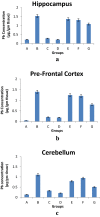Assessment of Role and Efficacy of Curcumin and Quercetin in Preventing Lead-Induced Oxidative Stress in Rats
- PMID: 35873616
- PMCID: PMC9300802
- DOI: 10.1007/s12291-021-01001-z
Assessment of Role and Efficacy of Curcumin and Quercetin in Preventing Lead-Induced Oxidative Stress in Rats
Abstract
Lead (Pb) is found in almost all phases in environment and biological systems. Pb stimulated oxidative stress is a state that involves the generation of free radicals beyond the permissible limits, which can deplete the antioxidant reserves and can result in oxidative stress, thus hampering the ability of the biological system to reverse the result. Exposure of rats to Pb (25 mg/kg body weight) for 8 weeks caused an increase in Pb levels in blood and brain. Activity of delta-aminolevulinic acid dehydratase (δ-ALAD) and antioxidant enzymes such as Superoxide dismutase (SOD) and Catalase (CAT) decreased in the blood of Pb-treated group with a concomitant increase in the level of lipid peroxidation (LPO) and no significant change in the level of reduced glutathione (GSH) level was found. Interestingly, co-treatment of Pb-treated rats with curcumin (30 mg/kg body weight) and quercetin (30 mg/kg body weight) for 8 weeks caused a significant decrease in Pb levels of blood and all brain regions versus those treated with Pb alone. A significant improvement in levels of MDA, δ-ALAD, SOD and CAT activities was observed in rats simultaneously treated with curcumin or Quercetin or both with lead. Therefore, the ameliorative impact of curcumin and Quercetin might be due to their antioxidant property hence were able to counter the oxidative stress generated by Pb. These results suggest that combination of curcumin and Quercetin could be utilized as a possible supplement with the relevant therapeutics in the suitable management of Pb toxicity.
Keywords: Curcumin; Lead; Oxidative stress; Quercetin; Rat model.
© Association of Clinical Biochemists of India 2021.
Conflict of interest statement
Conflicts of interestThe authors declare that they have no conflict of interest.
Figures






References
LinkOut - more resources
Full Text Sources
Miscellaneous
